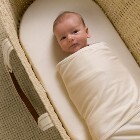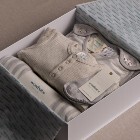One of the most common requests we get at The Sleep Store is to help babies sleep longer during the day. Not only are most babies not rested after a 20 or 45 minutes sleep, but it makes for a very tiring day when mum or dad don't get any time for a rest either!
Catnapping Solutions for Newborns
Does my baby need to sleep for longer during the day?
There are some babies who will only ever sleep for one sleep cycle, regardless of what you do! But these babies are far less common than those who can be encouraged to sleep longer at each day-time sleep.
A baby who sleeps well in the day will generally sleep better at night, feed well and be more settled than an over-tired baby.
If your baby wakes up grizzling or crying after 20 or 45 minutes, it is likely she is crying from tiredness rather than hunger. So we recommend that you try to resettle her for another sleep cycle and then feed her when she next wakes.
However if she wakes happy and can easily last until her next sleep time, then your baby may be happy with shorter sleeps....even if you would prefer she slept longer!!! You may just need to have an extra short sleep later in the day if your baby starts to get over-tired later in the afternoon.
Over time many babies do learn the resettling skills that means they can put themselves back to sleep after one sleep cycle and learn to have longer day sleeps without your help. Plus as babies get older they usually burn more energy and this in turn leads to longer day sleeps.
However it is well worth trying our tips below to see if you can increase the length of day sleeps - you will benefit from the longer opportunity for a rest and you will help your baby develop habits of longer day sleeps.
The following tips should help you increase the length of your baby's day sleeps:
Swaddling
Firm wrapping or swaddling is by far one of the most effective ways to increase the length of day sleeps for newborn babies. Newborn babies have such a strong startle reflex that unwrapped, they are very likely to startle themselves awake after one sleep cycle.
By firmly wrapping your baby and keeping their arms inside the wrap, your baby is more likely to remain relaxed and resettle.
Also if you do need to use some other techniques to help your baby into another sleep cycle (such as patting), this will be far more effective is baby is still wrapped.
We recommend the Miracle Blanket as the best wrap for newborns.
Also the SwaddleUp is great for babies who aren't usually wrapped, as it allows babies to sleep in the arms up position but provides some startle control.
As your baby's startle reflex wears off (towards 4 months), you may want to wrap with one arm out. However we recommend that you try firm wrapping with both arms in first, at least for a few days, and see if this has a positive effect on the catnapping. Plus if you currently wrap with arms up, we recommend you try our technique with arms down by the sides, as this stays wrapped for longer.
We have had many customers tell us that their baby doesn't like being wrapped, so they don't do it. However these babies have all slept far longer when their parents started effective swaddling during the day. We believe that babies don't know what they like, they are just babies! They are used to being firmly packaged in the womb, warm and snug, with little room to move. So swaddling is as close to that environment as possible.
What to wrap with
-
We recommend using a stretch cotton wrap at least 1m x 1m for newborns
-
1.2 x 1.2m once baby is over 3 months
-
Alternatively use a Miracle Blanket for the firmest wrap
-
Choose Love To Dream or arms up swaddle if your baby sleeps better with their arms up
Read more about swaddling
White noise
Along with swaddling, we believe that white noise is one of the most effective ways to help newborns sleep longer and resettle during the day.
White noise is similar to the swooshing, heartbeat and gurgling noises your baby heard inside your womb for 9 months - it's louder than a vacuum inside the womb! It makes sense that babies find it hard to settle and resettle in a quiet room when they are used to 80-90 decibels, 24/7 for 9 months.
White noise is also a very effective way of creating a consistent ssssshing sound, a sound which babies respond so well to. Ssssshing can be very exhausting to do, so why not let a CD or machine do it for you?
Play your white noise at the start of the sleep and on repeat through the sleep. Play it louder than your baby is crying, so she can hear it.
You can use a white noise CD or digital download or one of our white noise machines such as the Hushh or Dohm. They sound like sssshing and we get amazing feedback about how effective they are.
If you aren't currently using white noise, definitely add this to your catnapping plan of attack immediately. Even try the vacuum cleaner running under the bassinet if you need something to try right this minute!!!
Wake to sleep - Reset the sleep cycle with a gentle prod!
Here's a trick that may just be what you need! Go into your baby about 5 minutes before she usually wakes up from her nap. Gently prod her, enough that she stirs or moves slightly...but not enough to fully wake her.
At that point your baby should fall back into a deep sleep, and sleep through the waking that was about to occur.
We have had amazing feedback on this technique from lots of mums, so we look forward to hearing how it works for you.
Dummy
Using a dummy can be a great way to get your baby to resettle after one sleep cycle. It doesn't work for all babies, but it's well worth a try, especially if you have a sucky baby. Often baby wants to suck but doesn't yet need a feed, and they may well go back to sleep for another cycle once the sucking desire has been satisfied.
Recommended Products
Slings & carriers
Many newborns just want to be as close to mum as possible, as they miss the sensations of being in the womb. So often when your baby wakes after a very short sleep, having her close to you will help her fall back to sleep.
The easiest way to achieve this is to use a sling. This means your baby is in almost the same position as in the womb, but you are hands free and can carry on with whatever you are doing.
There are lots of different slings and wraps available, including the popular Boba wrap. Moby Wrap and Ergo Baby Carrier are also very popular.
Also using a firm swaddle offers some of the same 'cuddle' feeling as being held. And if your baby is swaddled before you are carrying them, it makes it easier to put your baby down without waking her.
Patting & Rocking
If your baby is still swaddled and you have had constant white noise playing loud, and baby will still not go back to sleep, try some patting, rub baby's tummy or stroke her forehead, or gently rock the bassinet.
Often this gentle movement will be enough to stop baby crying, relax and fall back to sleep.
As your baby gets closer to 3 months old, we strongly recommend that you work on weaning your baby off needing this type of intervention to get back to sleep. Try just patting until she is calm, rather than asleep. Then over the next few sleeps, try just a few pats then leave her to resettle herself.
Walks in the pushchair

Movement is another thing your baby was used to in the womb, and it is another very effective tool for helping your baby sleep for longer during the day.
You can either walk your baby for the whole sleep or use a walk to resettle baby for a 2nd sleep cycle. It works well to settle baby in their bed, swaddled and with white noise (see below). Then if your baby wakes after 20 or 45 minutes and won't resettle in the bassinet, you can then take them for a walk to get them back to sleep.
Keep baby firmly swaddled, as she will be much more likely to go back to sleep if she is still snug and unable to startle.
You may also want to use some portable white noise, such as the Hushh machine, which is brilliant for sleeping out and about.
Another option is a small radio on static.
Look for a bumpy place to walk, rather than smooth concrete. It seems the bumpier the walk, the better babies sleep!
Opportunity to resettle
Once your baby is over a couple of months of age, we recommend that you give your baby the opportunity to resettle by himself if he wakes at the 20 or 45 minute mark.
If you always rush in as soon as he makes a little noise, over time he learns he needs you to help him back to sleep, and he never gets the chance to practice going back to sleep.
Many babies grizzle or cry for a few minutes as they stir, wake and resettle back to sleep. This is quite normal and doesn't mean your baby is upset, hungry or ready to get up. For many babies it is just what they do in between sleep cycles, both day and night.
How long you give your baby to resettle is completely up to you, how hard your baby is crying and how old they are. However a good rule of thumb would be to give your baby about 5 minutes to see if they can go back to sleep before you try any other techniques.
Dark room
Close your baby's curtains and make his room nice and dark. Bright light can be stimulating to a baby, and may effect your baby resettling after one sleep cycle.
Invest in a blackout lining on your curtains, or Gro Anywhere blinds over the windows to see if that helps.
This becomes more of an issue with babies once they are over 4 months and are far more aware of their surroundings...and can see there are fun things to do when you get out of bed.
However lots of babies can still sleep really well in a lighter room, so this isn't an issue for all babies!
Feed/Awake Time/Sleep routine
We recommend using the feed/play/sleep routine during the day, which means you put your baby into bed when she shows tired signs. Then feed her when she wakes from her sleep.
However if your baby is a catnapper and sleeping for 45 mins or less, this means she would be getting fed every couple of hours or even more frequently. So do try to resettle her for another sleep cycle, so you don't feel like all you do is feed/into bed/feed etc!
It's very unlikely that your baby is hungry after an hour or 2 (once she's over a couple of months), it's much more likely that she needs more sleep and a bit of help to get back to sleep. Try some techniques like a carry or walk in the buggy to try and get another sleep cycle.
Avoiding falling asleep in the car
With babies over the age of 3 months, we recommend that you avoid letting your baby fall asleep in the car, as this reinforces catnapping habits.
For example, your baby may fall asleep 10 minutes before you get home, and think he has had his sleep. That means he then won't settle for another sleep in his cot, your routine will get completely out of whack and you will have a baby that will be really over-tired later in the day.
We find it works best to either go out after your baby's morning sleep or to go out early and put baby into his pushchair for his morning sleep when you get to your destination (wrapped or in sleeping bag, whatever you do at home).
Teaching your baby to self settle
As your baby gets closer to 4 months old, it's a good time to ensure your baby can settle himself to sleep. This means he will have the skills to resettle at the end of a 45-minute sleep cycle without your help (and will also have the skills to resettle in the night!).
So if you are helping your baby fall asleep with feeding or rocking, for either day sleeps or bedtime, this is a good place to start working on it to improve day sleeps.
Learning to self settle doesn't have to mean leaving your baby to cry, it just means you need to start a process where you wean your baby off needing you to fall asleep.
But I've tried all those things & nothing works!!!
For starters, make sure you have persevered with the tips and not just tried things once or twice. Plus you may need to increase the intensity that you try the techniques with - for example, very quiet white noise doesn't have much impact on catnapping but loud white noise makes a difference with most babies.
But if the above info doesn't make a difference for your baby, perhaps she is just going to be a catnapper in the near future.... some babies are happy with less sleep! Use your baby's temperament as a guide rather than what a book says about how long your baby should sleep for!
We do find that some parents get fixated on how much their babies sleep in the day, rather than just seeing this as a phase and enjoying their baby for who they are. Try not to compare with the mums in your coffee group for example, as hearing that other babies sleep for longer may drive you crazy and it might not even be true!
If you have tried all our catnapping tips and your baby is still sleeping for shorter sleeps, then so be it. Please try not to stress about it, just go with the flow in the meantime. You will likely find that some tips do work over time or that as your baby grows, her sleep changes.
Where to from here
For more information on helping newborns sleep longer, we recommend ordering a copy of The Happiest Baby DVD and Secrets of the Baby Whisperer.
To order other tools to help with catnapping, please click the links below.


























